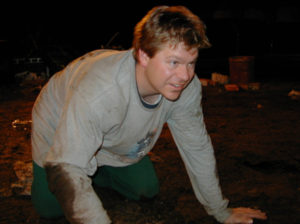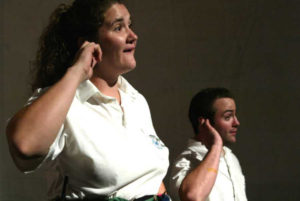20 years later: A blueprint for Colorado theatre

(Note: In 2002, I penned a forward-looking manifesto in The Denver Post speculating on what it would take for Denver to become a world-class theatre city over time. Well, time has passed, and here’s a look back. How are we doing? (PS: That second paragraph alone kills me, hah.)
BY JOHN MOORE
Originally published in The Denver Post, 2002.
In many ways, the curtain on the Denver-metro theatre scene could be described as half-raised.
The Denver Center Theatre Company is not so far removed from winning the 1998 Tony Award as the nation’s best regional theatre, Denver was chosen to launch the national tour of “The Lion King” last April and the Phil Anschutz-bankrolled Walden Family Playhouse promises to raise children’s theatre to a new standard when it opens March 4. The Denver Civic Theatre will re-open in April as an off-Broadway performing-arts center, and the historic Elitch Theatre has targeted 2005 for its own reopening.
In recent years, the DCTC not only unleashed the 10-play epic “Tantalus” on the world, but also “The Laramie Project.” That spawned a New York production, an HBO movie and now has been performed by scores of professional companies, with an average of 100 requests for rights submitted per day from high schools.
Things are good in Denver, but it is never mistaken for New York. Or Boston, Chicago or San Francisco. Some might add Minneapolis or Houston. Denver is a town with just 56 theatre companies – and shrinking. Ten folded or went dormant over the past year, including the Everyman Theatre Company just last week.
“Denver does not have a reputation as a world-class theatre city, and that is based mostly on the number of full-on, professional theatres it has,” said Robert Lewis Vaughan, a playwright and director of professional rights for Dramatists Play Service in New York. “Denver has only one (League of Regional Theatres) playhouse.”
And the one it has, the DCTC, is clawing its way out of budget shortages that resulted in $1.6 million in cutbacks the past 18 months.
Chicago, by comparison, has 20 professional LORT theatres. Seattle has five; San Diego three. The best theatre cities also have thriving, definable theatre districts, something that would be impossible to chart here outside the Denver Center.
So what can Denver do to become world-class? In short, the theatre community must become a stronger single entity; the state needs to recognize the economic impact of the arts and help them to grow; and most important, audiences must better support smaller theatres that produce new and experimental works beyond the mainstream.
What follows is a 10-part blueprint, but “it all has to start with community support,” said Vaughan, who chose Denver over three other cities to give his newest play its world premiere. “The Rest of the Night” bows at the Curious Theatre Company in April. “Denver has a reputation for very strong support aimed at the Denver Center, but in the best theatre cities, audiences and politicians support the smaller companies better than they do in Denver.”
Ten ways to raise the curtain higher

1. BE RELEVANT
Theatre companies here must find a way to speak to new and larger audiences. Where are the companies serving the disenfranchised? Where are the companies whose productions define this community as uniquely Denver? Where is the material that drives public dialogue? Where is our artistic soul?
CityStage recently wrapped a hopeful, month-long “Civil Liberties Theatre Project.” But until a community that is 18 percent nonwhite can support more than one Hispanic (Su Teatro) and one black (Shadow) company, the bases never will be covered. That means prominent members of those communities must step up to help make that happen.
Directors here have been falling over themselves trying to find post-9/11 relevance in material written pre-9/11. How about material that is relevant because it was written post-9/11?
2. AUDIENCES, STAND UP AND BE COUNTED
The reason more new work is not presented in Denver is the lack of audience support. More than 200,000 saw “The Lion King,” but Curious Theatre Company’s lesser-known “An Almost Holy Picture” drew just 1,620 over seven weeks. On Broadway, in about the same time, the same play was seen by nearly 66,000.
3. TRAIN OUR ACTORS
The worst thing to happen to theatrE education here was the 1989 closing of Loretto Heights, the premier theatre college in Colorado. Second-worst was the advent of body mics, which has resulted in the desecration of voice and singing technique by a new generation of actors who have grown up dependent on them. “That’s why we refuse to use them,” said Dick Devin, whose Colorado Shakespeare Festival is held primarily outdoors. “This is an endemic problem nationally since the shift in focus toward a modern, Stanislavsky approach to acting that does not emphasize articulation, voice and text quality. We need actors with the ability to walk onto an outdoor, 1,000-seat space and fill it. They’re getting harder to find.”

4. CREATE MORE CHILDREN’S THEATRE THAT DOES NOT CONDESCEND TO ITS AUDIENCE
You can put any 7-year-old in front of a stage and keep her engaged with shows like “Frosty’s Magic Hat” or “The Hardy Boys.” That’s called “day care.” Nothing here targets the crucial ages of 8-18, when you create theatregoers for life with relevant stories that are life-altering and, in some cases, life-saving. If the goal of adult theatrer is to galvanize, inspire and change lives, it should be doubly so in the children’s theatre. Walden will offer musicalized adaptations of classics, but someone needs to model The Children’s Theatre Company of Minneapolis, which has grown from a neighborhood playhouse into a professional theatre with a $9 million annual operating budget (half from ticket sales, half from private support).
“We strongly believe that our mission it to enlighten and to empower children,” said TCT’s Linda Jacobs. TCT recently gained national fame for “A Village Flake,” an adaptation of John Gardner’s “In the Suicide Mountain” (the story of a boy, girl and dwarf who talk one another out of committing suicide); and Gabriel García Márquez’s “A Very Old Man With Enormous Wings,” about an avatar who provokes the hearts and minds of children in an impoverished town. TCT is mounting a $24 million capital campaign with no state support that will create a second stage specifically for teenage audiences.
“Once theatre ceases to engage children,” Jacobs said, “they’re lost to you.”
5. FIX THE SAD ‘STATE’ OF AFFAIRS
With Gov. Bill Owens’ recent elimination of state funding for all metro-area arts organizations, Colorado fell to 50th in state arts funding. There is no way Colorado will ever be considered world-class in the arts when its governor says that arts are worth less than 25 cents per person per year. That’s down from 44 cents in 2002. The ’02 national average was $1.47. “That’s really embarrassing to Colorado from a national perspective,” Vaughan said. “It makes people shake their heads and wonder what’s going on there.”
6. ESTABLISH AN ECONOMICALLY POWERFUL LEAGUE OF COLORADO THEATRES
Colorado has a tiny but well-intentioned Colorado Theatre Guild, but it has only $3,000 in the bank. It desperately needs to model itself after the League of Chicago Theatres, an alliance of 130 of Chicago’s 200 companies that leverages its collective strength to promote and advocate for the theatre industry locally and nationally.
Started by 15 people in 1979, when the Goodman and Steppenwolf theatres looked a lot like the Buntport and LIDA Project do now, LCT now has a $6 million annual budget. It sells 100,000 discounted tickets per year (for $2 million) and produces a website, joint newspaper ads in the Chicago Tribune and combined marketing efforts that save theatres millions. LCT publishes a monthly magazine and the Stagebill program for 33 houses. Last week, a public-service announcement valued at $500,000 began airing on Chicago TV stations for free. “That’s a campaign that no individual theatre can or should have to do alone,” said executive director Marj Halpern.
In short, LCT stabilizes the community and protects its weakest members from failing. Be it ever so humble, local theatres must ally with the CTG and grow it together.
7. START COOPERATING
Many of Denver’s small theatres are reluctant to promote the work of others they see as potential competition. But in Seattle, five LORT theatres have blossomed in an environment of cooperation, including freely swapping mailing and donor lists, and mutual prop and costume storage.
“This is my biggest pet peeve,” said Devin. “The lack of cooperation is prevalent among community and amateur companies, and some never outgrow the unprofessional lack of desire to work together for the greater good.”
Devin has begun an unprecedented joint marketing campaign between his CSF, Denver Center Attractions, the DCTC, Nomad and Curious. “Across the nation, subscription sales are really hurting, as the national trend has continued toward single-ticket sales,” said Devin, which results in a dramatic drop in any company’s guaranteed income. So instead of receiving four shows for the price of three, CSF subscribers will get eight – one to each of the other theatres (whose subscribers will also receive a ticket to a CSF production).

8. FOUNDATIONS, GET CREATIVE
In this economy, foundation support is withering, and corporate sponsorship “is essentially completely banished,” Curious artistic director Chip Walton said. But a model of visionary thinking can be found in Atlanta, where two foundations joined forces last year to create the Loridans/Trammell Theatre Initiative. Together they will award more than $1 million to five midsize theatres over three years.
“Denver-based foundations have historically given money only to the (largest) organizations, because that’s where they get the most exposure,” said Walton. “But any arts community has an ecology like any other natural habitat, and just feeding the top of the food chain does not make for a healthy community. The (LTTI) is visionary in its understanding that you must support these smaller organizations, because they need it the most; that’s where you see the diversity of the community reflected most.”
In Denver, the most prominent foundations for theatre support include El Pomar and the Denver Foundation. “But the Gay and Lesbian Fund for Colorado is the only one that goes beyond the obvious in what it funds,” said retired producer Henry Lowenstein.
9. PAY ACTORS BETTER
Denver has only three Actors’ Equity (union) houses, which means they pay according to the national industry scale. That does not afford enough opportunities for many experienced Equity actors to live here. If Denver theatres want to attract top talent or, more important, keep the best homegrown actors home, they must recognize cost-cutting cannot begin with actor salaries.
10. DENVER CENTER, BE A BENEVOLENT LEADER
The Denver Center Theatre Company DCTC has routinely hoarded rights to nearly every relevant play in New York, even when it has no intention of performing it. It’s a practice that bruises egos and can keep interesting new work out of Denver for years.
NOTE: I wrote a Part 2, if you want to read more:
Waiting for Denver’s Godot: mid-tier theatres
BY JOHN MOORE
Originally published in The Denver Post, 2003.

The Denver theatre community is like a tall tree blooming on top like a canopy, but with a trunk so skinny it might be confused for a blocked artery.
The Denver Center for the Performing Arts is the foliage on the treetop. Too many people here believe if they patronize only the Denver Center Theatre Company and Denver Center Attractions, they will be fed a nutritionally balanced and nourishing cultural meal.
“We all have to figure out ways to attract those teeming hordes who cram into the Buell Theatre and give standing ovations to the latest touring musical,” said John Ashton, artistic director of the 100-seat Avenue Theater. “They are theatregoers, but they seem to have the notion that any theatre outside of the Denver Center enclave is not worth seeing.”
What outside observers always note first here is the absence of more mid-tier professional theatres. Atlanta has eight that operate on Small Professional Theatre contracts, have budgets over $500,000 and appropriate administrative staffs to support multifaceted programming. Outside the Denver Center, only the Arvada Center meets those criteria.
“This would require a collective community commitment to pay artists, a shared vision for an ecological balance in terms of programming and mission, and a unified voice to demand the things necessary to create this tier,” said Curious Theatre Company artistic director Chip Walton.
What can Denver to do fatten that trunk? Everyone needs to play a part, including theatres, audiences, and those who control public and private funds.
DIET OF CONSERVATIVE FARE
The greatest weakness of the Denver theatre community is its repetitively conservative fare. New and innovative works are the lifeblood of any artistic community, but in a down economy, familiar titles keep theatres open. More than a dozen companies have folded in the past 18 months – and none of them was producing standard fare. It’s not that the public won’t embrace new and difficult works. But theatre is expensive, and when the title is unfamiliar and the standards of the producing theatre are inconsistent, who can blame them for playing it safe when their time and money are at stake?
Companies have to produce at a more consistently high standard throughout their seasons. If a theatre presents four shining lights, with an unrealized afterthought thrown in, it’s that stinker that creates risk in the audience’s mind – and that’s what leads to empty seats during the best shows.
Of course, the best way for a new company to make a name is to be relevant – which is to say, more than topical. You need, said Cathy Reinking, a casting director for the TV show “Frasier,” to choose work that will rivet audiences to their seats.
” ‘Addicted’ drew the most eclectic audience I’ve ever seen for a theatre piece: teens, older kids; black, white; hip, conservative,” said Reinking, who lives in Colorado Springs and will direct next season at Bas Bleu in Fort Collins. “That’s because it’s so darned relevant and deals with a topic that is scary and somewhat taboo … and so we eat it up. The eclectic audience is out there.”

NEW COMPANIES HAMSTRUNG
But an “ecological balance” only can be achieved by audiences themselves that are willing to take an occasional creative and economic risk to nurture new companies.
“How else can a new company take its own risks and learn from its failures?” said the LIDA Project’s Brian Freeland. “As a theatre town, Denver has turned into a rent-driven market, where new companies and talent cannot financially explore and develop into powerful companies with strong visions and missions. We need a section of the theatre community that is young and raw.”
The Colorado Theatre Guild is run by tireless volunteers who simply do not have the time, money or clout to turn their good intentions into what their alliance desperately needs to be – an economically powerful service organization. For a struggling company there is power in numbers and bankruptcy in isolation. But it’s time for the CTG board to either come up with a long-range blueprint for how it plans to realize that mission or stop asking members to pay dues. Its goals should include joint marketing, seminars, conferences, activism and government lobbying. That kind of an organization requires a full-time president and staff. Until that happens, the CTG will never be more than a noble and modest special-interest group.
STATE AND LOCAL GOVERNMENTS
The Colorado office of tourism must recognize the value of the arts to the state’s economy and market them as an asset as aggressively as it does skiing. Theatre, from the Denver Center to mountain summer repertory companies, boosts tourism. The national tour of “The Lion King” had a $58 million economic impact. Enough said. But the collateral damage when you have a governor and legislature that are ambivalent about the arts cannot be overexaggerated.
The state arts budget has been cut from $1.9 million to $200,000 in one year, and it is difficult to persuade corporations, foundations and individuals to contribute when it is such an insignificant priority of the state. Atlanta’s bigger “small theatres” each receives up to $80,000 annually from three sources: state, county, and city arts councils.
“In Denver, we have only one of these three mechanisms functional: The Mayor’s Office of Art, Culture and Film offers ‘stabilization grants’ of approximately $2,200 per year,” said Walton. So what can individuals do? Educate and aggravate.
“The theatre community needs to educate the government and the private sector that the arts are important,” said Scott Dodson of Bas Bleu. “We tend to leave this job up to arts commissions or advocacy groups, but lawmakers want to hear from their constituents.”
THE BRIGHT SIDE
The problem with an essay like this is that you can leave the impression that the theatre community here is a dreadful abyss. It’s not. “I think theatre in this town is far better, more interesting, more varied and more ambitious than it has ever been in the 30 years I’ve been paying attention,” said Ashton. “The list of new, often innovative, high-minded theatres is pretty well known by now: Buntport, LIDA, the Bug. … They do original stuff that’s bold and creative, and are developing new audiences. They are led by energetic, intelligent and dedicated young people. “These are all good signs that theatre here is healthy.”
Leave a Reply